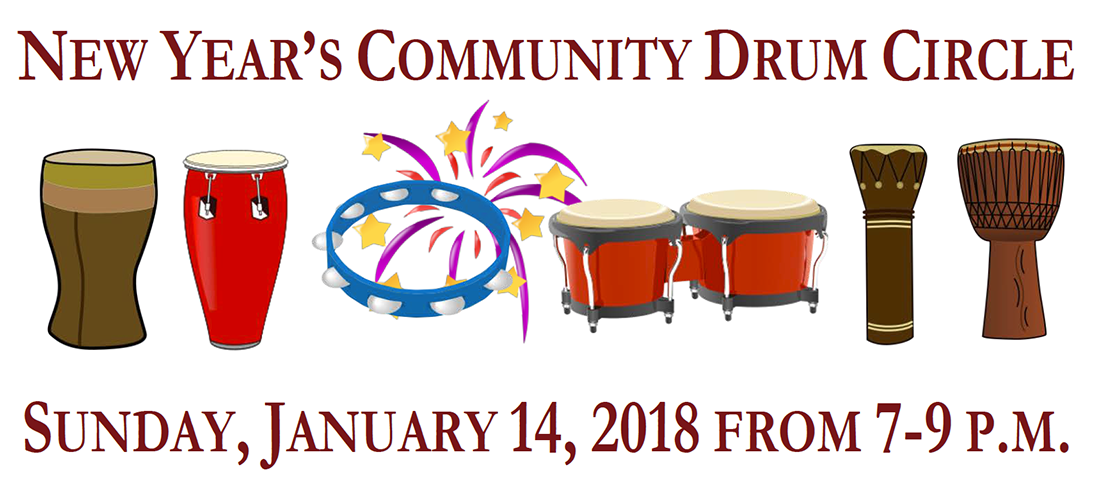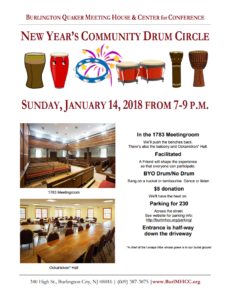
Sunday, January 14, 2018 from 7-9 p.m.
In the 1783 Meeting Room —
We’ll push the benches back. There’s also the balcony and Ockanickon* Hall.
Facilitated —
A Friend will shape the experience so that everyone can participate.
BYO Drum/No Drum —
Bang on a bucket or tambourine. Dance or listen.
$5 donation —
We’ll have the heat on.
Parking for 230 —
Across the street. See website for parking info: https://burlmhcc.org/parking/
**Entrance is half-way down the driveway**
*Chief of the Mantas Lenape tribe, a friend to the settlers in Burlington County and who is buried in our graveyard
In 1991, during testimony before the United States Senate Special Committee on Aging, Grateful Dead drummer Mickey Hart stated:
“Typically, people gather to drum in drum “circles” with others from the surrounding community. The drum circle offers equality because there is no head or tail. It includes people of all ages. The main objective is to share rhythm and get in tune with each other and themselves. To form a group consciousness. To entrain and resonate. By entrainment, I mean that a new voice, a collective voice, emerges from the group as they drum together.”i
Community drum circles are informal gatherings of people who meet for the purpose of playing drums together. They often take place in public settings such as parks or at the beach, but may also be organized via a community center or similar body. Instrumentation centers around drums and percussion, but may include other instruments, such as flutes, didgeridoos, and other non-percussion instruments. Community drum circles differ from facilitated or conducted drum circles in that the music is entirely improvised through a process of group interaction. There may be a facilitator or moderator who acts to shape the experience through discrete actions, such as helping to maintain a steady beat, helping those who need it, and generally managing the environment to see that everyone is able to participate fully. The participants make up the music as they go along, using their listening and playing skills to make musical connections and express themselves in any and all ways that feel right. One need not possess or purchase a drum to participate. Participation is voluntary and often includes drumming, singing or chanting, dancing, and listening. Community drum circles often attract both regular and drop-in participants of all ages and can take place just about anywhere. Community drum circles are the original and most popular form of improvised community drumming.ii
Etiquette
1. Don’t wear rings, watches or bracelets while playing hand drums. Metal jewelry can damage the head of the drum, as well as the drum itself. Shedding the jewelry will also protect your hands.
2. Ask permission before playing someone else’s drum. For some drummers their instrument is a very personal possession.
3. If someone gets up and leaves the circle to get a drink or go to the bathroom, don’t immediately jump in and take their seat. In some drumming communities the drummers will put something on their seat, cover their drum with something or lay their drum on its side to signify that they will be back.
4. Listen as much as you play. By listening to what’s going on around you, you will have a better sense of how to fit into the groove that is being created.
5. Support the fundamental groove that you hear being created in the drum song. You don’t have to be a rhythm robot and hold down the same part all night long. There is plenty of freedom to experiment and express your rhythmical spirit within the fundamental groove.
6. Leave enough rhythmic space in the circle for other players to express themselves. Don’t fill up the creative space with your own notes. Remember that it’s a conversation.
7. Play at the volume of the group. If you can only hear yourself, you’re probably not having a constructive musical relationship with the rest of the players in the circle. Good volume dynamics create good relationship dynamics. Play soft enough to hear everyone around you. Follow and support the dynamic changes in volume and tempo that the group will go through during a drum circle event.
8. Share the solo space. If you are at the advanced level of drumming expertise where soloing is available to you, then you know the excitement and pleasure of being able to play over, around and through the drum circle groove. Soloing through a drum circle groove is very much like a bird flying through the forest. The “solo air” can’t accommodate more than a few people soloing at the same time. If there is more than one soloist available in a circle be sure to share the solo space with them. The best way for two or three drum soloists to play through the groove together is to have a drum dialogue with each other. In a facilitated drum circle event, a good facilitator will find all of the advanced drummers in the circle and showcase them individually, encouraging them to trade solos with each other.
Advice
1. Enjoy the journey. In all the excitement, don’t forget to have fun. Although it will help you to follow the simple Drum Circle Etiquette guidelines, you don’t really have to be an experienced drummer to fully participate and have a good time.
2. Don’t worry, even if you might think that you are rhythmically challenged. Just get started and you will find rhythms inside of you that you didn’t know you had. By actively participating in the drum circle event, you will find that the excitement and rhythms that surround are all you need to fully contribute to the group song. You don’t even need to play a drum. You can bring a simple percussion instrument like a shaker, a bell or a woodblock. They are a lot easier to play than a hand drum.
3. Support the drum community experience. If you participate in a drum circle event for the first time, it’s best to play with an attitude of humility and support. Be observant of the actions and reactions of the more advanced drummers and you will learn much quicker.
4. Keep it simple. Listen for the pulse that will always be somewhere in the music, then play along and around it. It is like keeping the side of the pool within reach as you learn how to swim. The simple pulse will always be there for you to grab onto if you ever lose the rhythm while playing. Once you’re comfortable with the part you play, you can explore deeper rhythmic waters. Just keep the pulse in sight.
5. Just ask. Every rhythm event is different, and each has its own particular variations of drum circle etiquette. If you’re not sure what’s appropriate, just ask somebody. They will usually respond with supportive suggestions.
That’s it! There is a basic agreement in these kinds of events that each person in the circle is there to share their rhythmic spirit and personal energy with the community that is present. With this kind of group consciousness, a drum circle can be a very powerful yet intimate experience for participants to create unity in their community by drumming together. Your level of expertise is less important than how much of yourself you contribute to the experience. If every player is there to share his or her spirit and have fun, the musical part of any drum circle will take care of itself. iii
i Rhythm As A Tool For Healing and Health in The Aging process
ii https://en.wikipedia.org/wiki/Drum_circle
iii http://drummagazine.com/the-unwritten-rules-of-drum-circle-etiquette/
